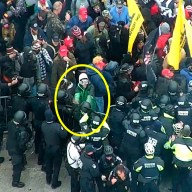‘Gueros’ The Mexican indie “Gueros” is not just shot in the now-trendy “Academy Ratio,” the name for the screen shape of classic movies and old TVs. It was made to appear like it came from a different era entirely. It borrows the highly stylized look from no-budget, No Wave Cinema indie classics, like the films of Jim Jarmusch, unfolding in stark but rapturous black-and-white. It also resembles, in its yen for deadpan comedy and casual surrealism, the work of fellow countryman, Fernando Eimbcke, especially his breakthrough, “Duck Season.” Like that film, “Gueros” is a hang-out movie, albeit one that slowly but surely turns political — like an “Y Tu Mama Tambien” in which the characters actually notice a world outside themselves. The setting is a single day in Mexico City, one that, for its two slacker, collegiate roommates Frede (Tenoch Huerta) and Santos (Leonardo Ortizgris), includes absolutely nothing to do. There’s a reason for that: school is closed due to a month-long student strike, of which neither wants a part. Their arrested development is only reinforced when Frede’s little brother, Tomas (Sebastian Aguirre), shows up, forced upon him by their irritated mother. Tomas fits right in, and boredom leads to pranks, and then pranks lead to wanderlust, and then wanderlust leads to an all-night journey that finds them engaging with politics after all. It’s here that “Gueros” can sometimes go too far, vying for maturity but mostly getting heavyhanded, in the manner of many feature debuts. First-timer Alonso Ruiz Palacios has some tonal problems to work out, but he hits the ground running when it comes to eccentric sense of humor. He’s prone to fits of playfulness and oddball poetry reminiscent of past no-budget greats, but it has its own specific shade of weird. Even when the symbolism is painfully on-the-nose — such as a tiger driven made by life in the zoo — it has a hallucinatory quality that overwhelms the obviousness.
Director: Alonso Ruiz Palacios
Stars: Tenoch Huerta, Leonardo Ortizgris
Rating: NR
3 (out of 5) Globes
‘Gueros’ is a beautiful, weird retro indie comedy

Kino Lorber
Follow Matt Prigge on Twitter @mattprigge


















